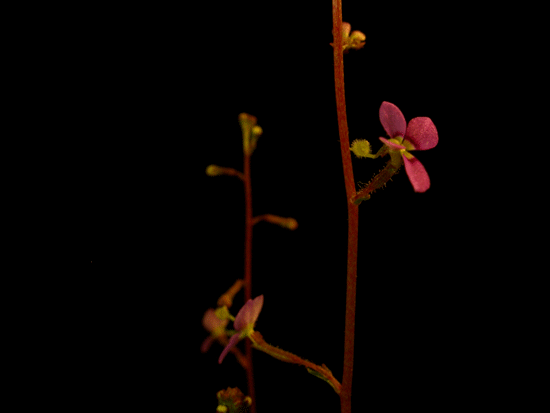
Tripping Triggers
Frank Carroll
This is not the title of the latest wild west movie, but a perfectly innocent pastime indulged in by wildflower lovers who happen to go bush-walking in summer in any area which is home to the genus Stylidium. This large genus contains 130 or so Trigger Plants.
Look for a perennial herb, from about 5 cm to 70 cm tall, with one or more spikes of pale pink to deep mauve flowers. (In Western Australia there are also species with red, yellow or whiteflowers.) Each flower appears to have four petals (actually there are five, but one is very small). To one side, between two of the petals, is a column made by the fusing together of the stamens and the style. It is sensitive to touch, and remains cocked until an insect goes to seek nectar in the centre of the flower, whereupon the trigger flies round and hits the visitor on the back. One can deceive the flower by touching it with a thin stem or grass blade; hence our pastime. After some minutes the trigger reverts to the ready position.
 |
Animation of Stylidium debile resetting after being triggered.
Each frame represents one minute
Photo by Ryan Kitko and reproduced under the GNU Free Documentation License |
The stamens develop before the stigma, so that a new flower dusts pollen on the backs of insects. As the flower matures the stamens cease activity and the stigma develops, picking up pollen brought to it from other flowers. Another one of the marvels of nature is that each species of Stylidium has its trigger of a characteristic length and swinging at such an angle that pollen is deposited and collected from its own particular spot on the back of the insect; so that when several species grow close together, hybridization is largely avoided.
Trigger Plants occur in south-east Asia, Australia and New Zealand, but Australia is their headquarters. Authorities differ as to the exact number of Australian species, but it is approximately 120. 14 species in Queensland, 7 in New South Wales, 6 in Victoria, 7 in South Australia, at least 1 in Tasmania, 13 in the Northern Territory and 86 in Western Australia. There are two common growth habits. The first is a clump of long grass-like leaves, with a tall unbranched flower spike rising from its centre. The other is a rosette of rather broad spoonshaped leaves that rest flat on the ground, and give rise to one or several shorter, many-branched flower spikes resembling the shape of miniature Christmas trees.
The tall, grass-leaf trigger plant, Stylidium graminifolium, with its bright pink or mauve flowers, is a feature of grassy areas of the Blue Mountains, the Kosciusko Plateau (the alpine meadows around The Chalet at Charlotte Pass are aglow with it every January) and of the Tasmanian central highlands. In other parts of eastern Australia they are not so conspicuous, though they are not rare.
 |
The trigger of a Stylidium species depositing pollen
onto the head of a bee. Photo: Sheryl Tobin |
In February one year I was delighted to discover by accident a colony of trigger plants at the top of Herveys Range, close to the main road, west of Pipers Lookout, at the edge of an open forest of tall eucalypts associated with Acacia simsii. On earlier occasions I had often walked over the flat rosettes of light green leaves and not recognised them. Further searching has revealed two other localities by the roadside in the dry open forest between Mt. Spec and Hidden Valley. In that area, early summer bushfires notwithstanding, leaf rosettes and the tiny 'trees' of delicate pink flowers were there at Easter time.
The Townsville district specimens seem to belong all to the same species. The points of the spoon-shaped (spatulate) leaves are often prolonged into a thin hair. The flower spikes seen were up to 15 cm tall. The flowers were pale pink with linear markings of deeper purple. The tiny seeds are held in small papery capsules. Viewed with a magnifying glass, the seeds appear rounded and of a medium brown colour. Try to identify your local species and learn more of these plants and their distribution. In the meantime, let me invite you - especially in summer and autumn - to come tripping triggers.
From the newsletter of the Pine Rivers Branch of the Society for Growing Australian Plants (Queensland), October 2006.
Australian Plants online - 2009
Australian Native Plants Society (Australia)
|